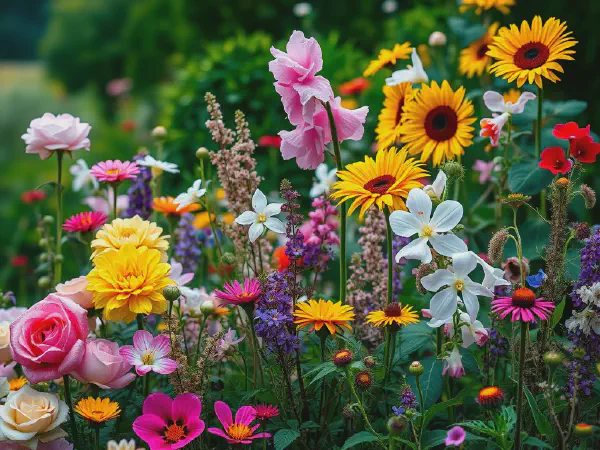Explore the Different Types of Flowers and Their Beauty

Exploring the Diverse Types of Flowers
Flowers are nature's most beautiful creations, designed for reproductive purposes, they come in a variety of shapes, sizes, and colors. This article explores various types of flowers, each with unique characteristics, growing conditions, and uses. Understanding these diverse types of flowers can enhance your gardening experience and add beauty to any landscape.
When considering the types of flowers, we can categorize them into annuals, perennials, wildflowers, flowering shrubs, and tropical flowers. Each category has distinct features that cater to different gardening needs and aesthetic preferences. From the vibrant blooms of annuals that provide instant color to the long-lasting beauty of perennials, knowing your options is key to a thriving garden.
Annual flowers complete their life cycle in one growing season, often providing a burst of color and continuous blooms throughout their short life. On the other hand, perennial flowers can return year after year, offering not only beauty but also resilience. Wildflowers serve as a reminder of nature's untamed beauty, while flowering shrubs can establish a garden’s structure and provide habitat for wildlife. Tropical flowers, with their exotic appeal, bring a taste of the tropics to gardening enthusiasts worldwide.
While selecting the right types of flowers, consider the climate of your region, the space you have available, and the specific aesthetic you want to achieve. The right flower types will not only beautify your garden but also attract beneficial pollinators and contribute to a sustainable ecosystem. Each flower type has its requirements and characteristics, making understanding these crucial for successful gardening.
In this article, we will delve deeper into the various categories of flowers, exploring their particular traits, care tips, and roles in the ecosystem, as well as suggesting popular varieties within each type that you can incorporate into your own garden design.
Annual Flowers
Annual flowers are characterized by their life cycle, which lasts only one growing season. After flowering and producing seeds, they die off at the end of that season. This trait allows for a diverse range of color and style options each year, as gardeners can enjoy experimenting with different varieties each season.
Some popular types of annual flowers include marigolds, petunias, zinnias, and pansies. These flowers are known for their vibrant colors and ability to bloom profusely, making them favorites for garden beds and container arrangements.
Annual flowers thrive best in well-drained soil and require plenty of sunlight. They are often planted in the late spring after the last frost for the best growth and flowering results. Warmer climates allow for a longer growing season for these flowers.
The flowering season for annuals varies widely, but many will bloom from early summer through the fall, providing a continuous display of color throughout the summer months. Regular deadheading can encourage further blooming and prolong their flowering period.
Perennial Flowers
Perennial flowers are plants that live for more than two years, returning each season with more robust blooms. Unlike annuals, they typically grow steadily and have a deeper root system, allowing them to survive periods of drought.
Common types of perennial flowers include daisies, coneflowers, lavender, and peonies. These flowers often provide a burst of color during their flowering season, creating a beautiful garden backdrop year after year.
Caring for perennial flowers includes proper watering, mulching, and deadheading spent flowers to encourage new growth. Perennials also benefit from division every few years to maintain vigor and promote flowering.
When choosing perennials for your garden, consider factors such as soil type, local climate, blooming times, and the overall aesthetic you wish to achieve. Mixing different perennials that bloom at various times ensures a continuous display throughout the growing season.
Wildflowers
Wildflowers are flowers that grow naturally in the wild, often thriving in specific regions and climates. Identifying common wildflowers helps gardeners appreciate the native flora and incorporate them into their gardens if desired.
Wildflowers play a crucial role in ecosystems as they provide food and habitat for various pollinators like bees and butterflies. Their resilience and adaptability to local conditions make them valuable in promoting biodiversity.
To grow wildflowers, gardeners should select native seeds, prepare the soil properly, and allow the flowers to self-sow. An area with minimal disturbance and natural conditions is ideal for growing a vibrant wildflower patch.
Wildflower habitats are widespread, from meadows and fields to roadsides and riverbanks. Planting native wildflowers can enhance the local ecology and contribute to a healthier environment.
Flowering Shrubs
Flowering shrubs are woody plants that produce blossoms, adding structure, fragrance, and seasonally colorful displays to gardens. They can range from small compact varieties to larger shrubs that can act as privacy screens.
Maintenance of flowering shrubs involves regular pruning, watering, and ensuring they have suitable soil conditions. Many flowering shrubs also benefit from being fertilized during the growing season to maximize blooming.
Flowering shrubs typically bloom in spring or summer, with some varieties providing autumn color as well. Selecting shrubs that bloom in different seasons can create year-round interest in the garden.
Popular flowering shrubs include hydrangeas, azaleas, and rhododendrons. These shrubs are often used for landscaping purposes, providing both visual appeal and practical benefits such as noise reduction and habitat for wildlife.
Tropical Flowers
Tropical flowers are known for their striking colors and exotic shapes, often found in regions with warm climates. They are typically characterized by their vibrant hues and lush foliage, making them standout features in any garden.
Examples of tropical flowers include hibiscus, orchids, and plumerias. Known for their unique beauty, these flowers often require higher humidity and warmth to thrive.
Growing tropical flowers in colder climates can be achieved by planting them in pots that can be moved indoors during colder months. Creating a greenhouse environment or using indoor lighting can also help simulate tropical conditions.
Tropical flowers are frequently used in arrangements due to their stunning appearance and ability to last long after being cut. They are popular choices for decorative displays, weddings, and special events.
